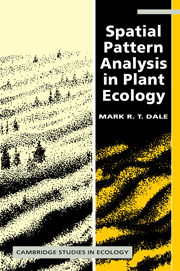Book contents
- Frontmatter
- Contents
- Preface
- 1 Concepts of spatial pattern
- 2 Sampling
- 3 Basic methods for one dimension and one species
- 4 Spatial pattern of two species
- 5 Multispecies pattern
- 6 Two-dimensional analysis of spatial pattern
- 7 Point patterns
- 8 Pattern on an environmental gradient
- 9 Conclusions and future directions
- Bibliography
- Glossary of abbreviations
- List of plant species
- Index
3 - Basic methods for one dimension and one species
Published online by Cambridge University Press: 04 December 2009
- Frontmatter
- Contents
- Preface
- 1 Concepts of spatial pattern
- 2 Sampling
- 3 Basic methods for one dimension and one species
- 4 Spatial pattern of two species
- 5 Multispecies pattern
- 6 Two-dimensional analysis of spatial pattern
- 7 Point patterns
- 8 Pattern on an environmental gradient
- 9 Conclusions and future directions
- Bibliography
- Glossary of abbreviations
- List of plant species
- Index
Summary
Introduction
Several methods have been proposed to detect the scale of pattern in vegetation; most of them analyze density data in strings or rectangular arrays of contiguous quadrats by examining how variance depends on the size of blocks of quadrats which are lumped together in the analysis (e.g., Greig-Smith 1952; Hill 1973; Usher 1975). In this chapter, we will review and illustrate the basic methods for studying the spatial pattern of a single species in one dimension along which there is no environmental gradient. The kind of data under consideration are therefore density or presence/absence data collected in a string of contiguous quadrats (see Chapter 2).
Data
We will begin by considering a standard pattern consisting of a regular square wave and let the scale of the pattern be B quadrat units. Throughout the transect, gaps of B quadrats, each of density 0, alternate regularly with patches of B quadrats, each with density d. There are several ways in which this basic pattern can be modified to be made less regular:
1. The pattern is ‘unbalanced’ with the patch:gap ratio different from 1:1 but the patch size (p quadrats) and the gap size (g quadrats) are both constant for the entire length of the transect. For a given value of d, unbalanced patterns have a lower intensity than balanced patterns. In forest communities, the spatial pattern of the canopy will often be unbalanced in this way with the patches of canopy being considerably larger than the gaps between them.
- Type
- Chapter
- Information
- Spatial Pattern Analysis in Plant Ecology , pp. 50 - 99Publisher: Cambridge University PressPrint publication year: 1999
- 1
- Cited by



